Exam 2 – A&P 1 – Epithelial Tissue – Flashcards
Unlock all answers in this set
Unlock answersquestion
The skin carries out the first step in the synthesis of vitamin D. True or False.
answer
True
question
Living keratinocytes exfoliate from the epidermis as tiny specks called dander. True or False.
answer
False
question
The deeper of the two layers of the skin is the hypodermis. True or False.
answer
False
question
The youngest keratinocytes are found in the stratum basale. True or False.
answer
True
question
Melanin, hemoglobin, and carotene give color to the skin. True or False.
answer
True
question
Albinism is the genetic lack of melanin that results in a milky white coloration of the skin. True or False.
answer
True
question
Embarrassment can be perceived by an abnormal coloration of the skin called cyanosis. True or False.
answer
False
question
Freckles are elevated patches with an abnormal coloration of the skin. True or False.
answer
False
question
Hair and nails are composed of collagen True or False
answer
False
question
The acidity of sweat contributes to the acid mantle that inhibits bacterial growth in the skin. True or False
answer
True
question
The skin does not include A. the epidermis. B. the papillary layer. C. the hypodermis. D. the stratum basale. E. the dermis.
answer
C. the hypodermis
question
These are all types of cells found in the epidermis except A. melanocytes. B. fibroblasts. C. stem cells. D. keratinocytes. E. tactile (Merkel) cells.
answer
b. fibroblast
question
Skin covering the __________ has sweat glands but no hair follicles or sebaceous (oil) glands. A. forearm B. buttocks C. abdomen D. fingertips E. back
answer
fingertips
question
Most of the skin is ___________ mm thick. A. 0.01 to 0.02 B. 0.1 to 0.2 C. 1 to 2 D. 10 to 20 E. 100 to 200
answer
1 to 2
question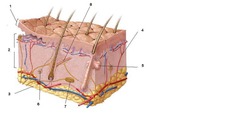
This image shows structures of the skin and subcutaneous tissue. What does "3" represent? A. stratum basale B. stratum spinosum C. stratum corneum D. dermis E. hypodermis

answer
hypodermis (#3)
question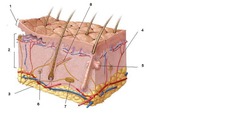
This image shows structures of the skin and subcutaneous tissue. What does "1" represent? A. stratum corneum B. epidermis C. papillary layer D. reticular layer E. hypodermis

answer
epidermis (#1)
question
This image shows structures of the skin and subcutaneous tissue. ________ are found in the layer of the skin represented as "2". A. Collagen and living keratinocytes B. Collagen and dead keratinocytes C. Collagen and fibroblasts D. Elastic fibers and melanocytes E. Elastic fibers and dendritic cells
answer
collagen and fibroblasts
question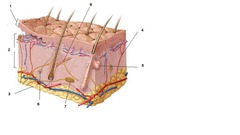
This image shows structures of the skin and subcutaneous tissue. Layer "1" represents _____, whereas layer "2" represents ___________. A. simple squamous epithelium; areolar tissue B. stratified squamous epithelium; dense irregular connective tissue C. dense irregular connective tissue; stratified squamous epithelium D. simple squamous epithelium; stratified squamous epithelium E. dense regular connective tissue; stratified squamous epithelium

answer
stratified squamous epithelium; dense irregular connective tissue
question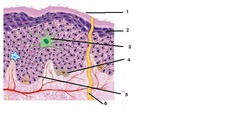
This image shows strata and cell types of the epidermis. ________ represents a living keratinocyte belonging to the stratum basale. A. "1" B. "2" C. "3" D. "4" E. "5"

answer
5
question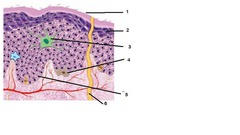
This image shows strata and cell types of the epidermis. "2" represents a _________, whereas "4" represents a _________. A. dead keratinocyte; dendritic cell B. living keratinocyte; dead keratinocyte C. melanocyte; dendritic cell D. living keratinocyte; melanocyte E. melanocyte; living keratinocyte

answer
living keratinocyte ; melanocyte
question
This layer of the epidermis consists of up to 30 layers of dead cells. A. stratum basale B. stratum spinosum C. stratum granulosum D. stratum lucidum E. stratum corneum
answer
stratum corneum
question
Which of the following are associated with the sense of touch? A. fibroblasts B. melanocytes C. keratinocytes D. dendritic (Langerhans) cells E. tactile (Merkel) cells
answer
tactile (Merkel) cells
question
The fastest rate of mitosis happens in the A. stratum basale. B. stratum spinosum. C. stratum granulosum. D. stratum lucidum. E. stratum corneum.
answer
stratum basale
question
These cells stand guard against toxins, microbes and other pathogens. A. keratinocytes B. melanocytes C. adipocytes D. dendritic (Langerhans) cells E. tactile (Merkel) cells
answer
dendritic (Langerhans) cells
question
Fingerprints left on things we touch are associated with A. dermal papillae. B. epidermal ridges. C. stratum basale. D. subcutaneous tissue. E. subcutaneous fat.
answer
dermal papillae
question
Calluses or corns are the result of accelerated multiplication of A. melanocytes. B. keratinocytes. C. fibroblasts. D. tactile cells. E. red blood cells.
answer
keratinocytes
question
The ___ is absent from most epidermis. A. stratum basale B. stratum spinosum C. stratum granulosum D. stratum lucidum E. stratum corneum
answer
stratum lucidum
question
Leather is mostly made of the __________ layer of the dermis, which is very tough due to the high concentration of ____________ fibers. A. areolar; collagen B. areolar; keratin C. reticular; collagen D. reticular; keratin E. papillary; keratin
answer
reticular; collagen
question
The hypodermis usually has an abundance of this tissue. A. epithelial tissue B. muscular tissue C. nervous tissue D. adipose tissue E. keratinized tissue
answer
adipose
question
The reddish color of the skin of the lips is primarily due to this pigment. A. hemoglobin B. myoglobin C. melanin D. carotene E. keratin
answer
hemoglobin
question
Ethnic differences in skin color are primarily caused by differences in A. UV radiation exposure. B. quantity of hemoglobin carried in the blood. C. quantity of melanin produced. D. number of melanocytes. E. number of keratinocytes.
answer
quantity of melanin produced
question
A ___ is an elevated patch of melanized skin. A. hemangioma B. mole C. freckle D. flexion line E. friction ridge
answer
mole
question
A pilus is A. a hair. B. a hair follicle. C. a tiny muscle that moves a hair. D. a sensory nerve fiber around the base of a hair. E. a gland associated with a hair follicle.
answer
a hair
question
Blood vessels in the _________ provide a hair with its sole source of nutrition. A. bulb B. root C. shaft D. dermal papilla E. medulla
answer
dermal papilla
question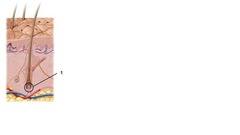
This image shows the structure of a hair and its follicle. What does "1" represent? A. bulb B. root C. shaft D. medulla E. cuticle

answer
bulb
question
The contraction of the piloerector muscles (pilomotor muscle or arrector pili) in humans causes A. hairs to stand on end trapping an insulating layer of warm air next to the skin. B. generation of heat to raise the body temperature. C. hairs to stand on end to make the individual appear bigger. D. hairs to stand on end with no apparent function. E. increased ability to feel pain.
answer
hairs to stand on end with no apparent function
question
Each hair grows in an oblique epithelial tube called a(an) A. hair follicle. B. vellus. C. pilus. D. bulb. E. dermal papilla.
answer
hair follicle
question
37. Mitosis in the __________ accounts for growth of the nail. A. nail plate B. nail fold C. eponychium D. hyponychium E. nail matrix
answer
nail matrix
question
The oil of your scalp is secreted by __________ glands associated with the hair follicles. A. merocrine sweat B. apocrine sweat C. sebaceous D. ceruminous E. mammary
answer
sebaceous
question
Secretions from __________ glands contribute to the acid mantle that inhibits bacterial growth on the skin. A. mammary B. ceruminous C. sebaceous D. sweat
answer
sweat
question
____________ is/are formed partly from the secretions of glands in the external ear canal. A. Sebum B. Cerumen C. Sweat D. Scents E. Mucus
answer
cerumen
question
Which two strata of the epidermis are most susceptible to cancer? A. corneum and lucidum B. basale and corneum C. spinosum and basale D. granulosum and spinosum E. lucidum and granulosum
answer
spinosum and basale
question
The least common but most deadly type of skin cancer is A. basal cell carcinoma. B. squamous cell carcinoma. C. melanoma. D. skin lymphoma. E. skin sarcoma.
answer
melanoma
question
Each hair grows in an oblique epithelial tube called a(an) A. hair follicle. B. vellus. C. pilus. D. bulb. E. dermal papilla.
answer
hair follicle



